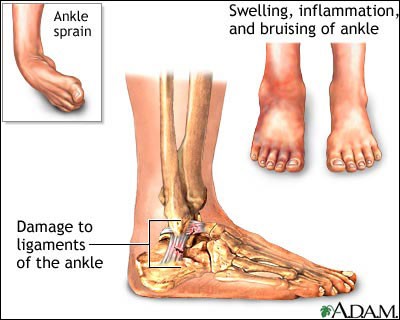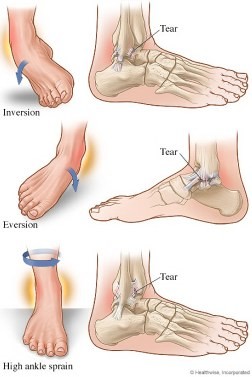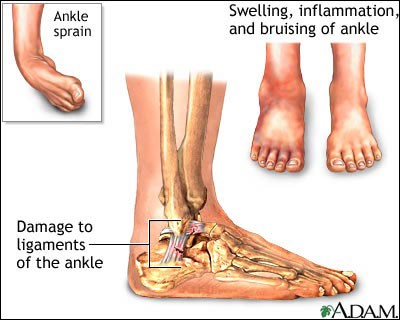What is a sprain?
A sprain is a stretched or torn ligament. Ligaments connect one bone to another bone at a joint and help keep the bones from moving out of place.
The most common site of sprains is the ankle. An ankle sprain can happen when you fall, when you suddenly twist your ankle too far, or when you force the joint out of it's normal position (for example, when you land awkwardly on your foot after jumping). Most ankle sprains occur during sports activities or when walking or running on an uneven surface.
The signs of an ankle sprain can include:
- pain or tenderness
- swelling
- bruising
- inability to walk or bear weight on the joint
- stiffness
The severity of an ankle sprain depends on how badly the ligaments are stretched or torn. If the sprain in mild, there may not be much pain or swelling, and the ligaments may only be stretched. If the sprain is severe, one of more ligaments may be torn, and the join may be severely swollen. A severe sprain can also be extremely painful.
How are ankle sprains diagnosed?
Your doctor will usually be able to tell if you have a sprain by asking you some questions about how the injury occurred and by examining your ankle. You doctor may also want to take an x-ray of your ankle to make sure that it's not fractured or broken.
How can ankle sprains be treated?
Many doctors suggest using the RICE approach--Rest, Ice, Compression, Elevation--for treating ankle sprains (see the box below).
RICE approach
Rest--You may need to rest your ankle, either completely or partly, depending on how serious your sprain is. Use crutches for as long as it hurts you to stand on your foot.
Ice--Using ice packs, ice slush baths or ice massages can decrease the swelling, pain, bruising and muscle spasms. Keep using ice for up to 3 days after the injury.
Compression--Wrapping your ankle may be the best way to avoid swelling and bruising. You'll probably need to keep your ankle wrapped for 1 or 2 days after the injury and perhaps for up to a week or more.
Elevation--Raising your ankle to or above the level of your heart will help prevent the swelling from getting worse and will help reduce bruising. Try to keep your ankle elevated for about 2 to 3 hours a day if possible.
Will I need to wear a brace?
This will depend on how serious your sprain is, if you have other ankle injuries and how your doctor thinks your sprain should be treated. You may need to wear a brace or padded plaster, plastic or fiberglass splint for 10 days to 6 weeks. A brace or splint keeps the bones and injured ligaments from moving, which reduces pain and speeds healing.
How long before I can use my ankle?
This depends on how serious your sprain is. If your sprain is mild, your doctor may suggest that you start trying to use your ankle again fairly soon--from 1 to 3 days after your injury.
Special exercises are sometimes needed to regain strength and to help reduce the chance of ongoing problems. Your ankle may need to be supported by taping or bracing to help protect it from reinjury.
What about medicine for pain?
If you need medicine to ease the pain, try acetaminophen (brand name: Tylenol) or ibuprofen (brand names: Advil, Motrin, Nuprin).
What is the best way to use ice?
Putting ice on your ankle can be very helpful, but you also need to be careful. The cold can damage nerves if the ice is left in place too long.
Ice can be left on your ankle for up to 20 minutes at a time. When your skin feels numb, it's time to remove the ice. Use ice treatments every 2 to 4 hours for the first 3 days after your injury. Ice treatments can consist of ice packs, ice slush baths or ice massages.
To use ice packs, partly fill a plastic bag with crushed ice. Wrap a thin, wet cloth around your injury. Place the ice pack over this and then wrap an elastic bandage around the ice pack to hold it in place.
For ice slush baths, fill a large bucket with water and ice. Place your ankle in the bucket until the skin gets numb.
Ice massages can work well for small areas. Freeze water in 4- to 8-ounce styrofoam (coffee) cups. Tear the top part of the cup away from the ice. Hold the covered end and slowly rub the ice over the sprained area with a circular motion. Don't hold the ice on one spot for more than 30 seconds.
How do I wrap a sprained ankle?
Start by cutting out a horseshoe-shaped pad from 1 x 4- to 3 x 8-inch-thick felt. Put this pad around the outside of your ankle joint on both sides of your foot, with the open end facing up.
Then wrap an elastic bandage, such as an Ace bandage, in a basket-weave "figure-of-eight" pattern. Leave your heel exposed. Reinforce your wrap with 21 x 2-inch adhesive tape over the elastic bandage.
Ask your doctor to show you how to do this. The ankle shouldn't be wrapped so tightly that the blood flow is cut off.
How soon can I exercise or play sports?
If you're an athlete, you'll probably be able to return to your sport in several weeks, depending on how serious your injury is and what sport you're involved in. When participating in sports, you may need to keep your ankle braced or wrapped for support and protection.
Bicycling, swimming or even running are usually okay to return to right away if they don't cause pain during or after exercise. But you'll still need to avoid pivoting and twisting movements for 2 to 3 weeks.
How can I prevent reinjury?
When your doctor feels you're ready to exercise again, you can help prevent further sprains and setbacks by wearing a semirigid ankle brace when you exercise for another 1 to 2 months.
Special wraps that use hook and loop fasteners, or air-filled or laced braces may also help prevent reinjury. Wearing high-top tennis shoes may also help prevent ankle sprains if your shoes are laced snugly and if you also tape your ankle with a wide, nonelastic adhesive tape. Elastic tape or braces are usually not helpful because the elastic gives too much around the joint.
Once your sprain has completely healed, a program of ankle exercises will also help prevent reinjury by making the muscles stronger, which provides protection to the ligaments. Ask your doctor to recommend an exercise program.








